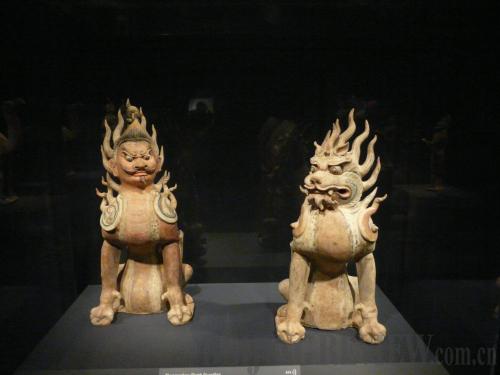|
 |
|
BODYGUARDS: This pair of tomb guardians, standing just over two feet high, were excavated in Gansu in 2009 (MAGGIE RAUCH) |
A series of related coincidences—and some very diligent work on the part of several individuals—brought an unprecedented China-themed program to a museum in New England this year. The events that led to the exhibition of some of the most remarkable archaeological artifacts unearthed in China in the past 20 years affected lives on three continents. It shed new light on and exposed audiences to events spanning the Northern Wei Dynasty (386-557), the restive dawn of the 20th century in China and the summer of Beijing's hosting of the 2008 Summer Olympics.
At the center of this saga is the Sterling and Francine Clark Institute (the Clark) in Williamstown, Massachusetts, a college town in the rolling Berkshire hills. Williamstown is as far from China's cities in character as any American locale, but the trio of China exhibits at the Clark is a true reflection of its legacy. Before the institute's founder, Sterling Clark, found fame as a philanthropist and art collector, he was an explorer who led and documented an expedition through northern China in 1909.
"People know Clark as an art collector and horse breeder—this gives some insight into his 'pre-history,'" said Michael Conforti, director of the Clark, referring to the institute's renewed interest in Clark's China experience, which he chronicled in a detailed travelogue, "Through Shen-Kan" (referring to Shanxi and Gansu, the provinces the group explored and mapped). The Through Shen-Kan exhibit displays objects from that journey, such as the surveying instruments used to map the route and some of the animal specimens the group collected and sent to the Smithsonian Institute.
Clark's book is a historical and scientific treasure on its own, but it also played a role in the museum's opportunity to display recently excavated findings from Shanxi and Gansu in Unearthed: Recent Archaeological Discoveries from Northern China, which runs through mid-October this year. The star attraction of Unearthed is a complete sarcophagus built from sandstone. Dating from the 5th century, it is the only object of its kind—an 8-by-12-foot sarcophagus modeled on a traditional Chinese house, built for high-ranking official Song Shaozu during the Northern Wei Dynasty and excavated in Datong, China's northwest Shanxi Province, in 2004. At 10 tons, the structure was so heavy that the Shanxi Provincial Museum could only display its facade, so its run at the Clark marks the first time the complete sarcophagus is on view.
Also in the exhibition are several objects from a tomb discovered in 2009 in Gansu. Among the most striking pieces in that collection are terra cotta tomb guardians over four feet high, still retaining faint hints of the original paint jobs they received during the Tang Dynasty (618-907).
|
